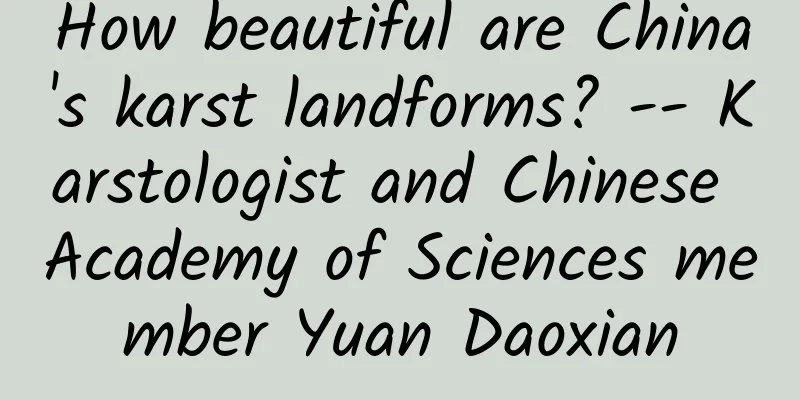How beautiful are China's karst landforms? -- Karstologist and Chinese Academy of Sciences member Yuan Daoxian

|
Every year at the beginning of the school year, the Qingmuguan Underground River Observation Site in Qingmuguan Town, Chongqing, attracts a large number of doctoral and master students from the School of Geographical Sciences of Southwest University to come for field investigation and research. From the accumulated observation data, under the background of returning farmland to forest and rural revitalization, the groundwater here is generally in a good state. "The Qingmuguan River Basin is just one of the observation sites of the Chongqing Jinfoshan Karst Ecosystem National Field Scientific Observation and Research Station." Yang Pingheng, a professor at the School of Geographical Sciences of Southwest University, told reporters that for many years, Yuan Daoxian, an academician of the Chinese Academy of Sciences and a professor at the School of Geographical Sciences of Southwest University, has led a team to combine observation sites with different research directions into one, providing scientific data and theoretical support for solving ecological and environmental problems in karst areas and promoting the construction of ecological civilization in the upper reaches of the Yangtze River. Recently, Yuan Daoxian was awarded the Lifetime Achievement Award by the Karst Commission of the International Association of Hydrogeologists. Since the establishment of the commission 50 years ago, only three scientists in the world have received this honor. Working in the field of karst geology As an internationally renowned geologist, hydrogeologist, karstologist, and my country's first academician in the field of karst geology, Yuan Daoxian devoted his entire life to promoting the development of the country's geological science. "At that time, the country lacked talents in geological research, and I responded to the call of the Party and the government to embark on the road of geological research." Yuan Daoxian said in retrospect. In the spring of 1950, Yuan Daoxian was admitted to the geological deposit major of Nanjing Geological Prospecting College. At that time, there were very few geologists in China, which was far from meeting the needs of the construction of New China. He couldn't wait to contribute to the construction of the country, and devoted himself to the "barren" soil of geological research at that time, and this rooted for nearly 70 years. "Field surveys are dangerous, but also interesting." Yuan Daoxian still remembers clearly that when he was investigating an underground river in Guilin, a golden ring snake crawled past him. At the critical moment, Yuan Daoxian quickly took out his hammer and smashed the snake to pieces. On the way back, he and his assistant found more and more snakes. It was not until they were safely out of the cave that they learned from the local people that they had entered a snake den. "my country is a major karst country with a karst area of more than 3.4 million square kilometers, which accounts for more than 30% of the country's land area. It is one of the rare 'natural karst archives' in the world and should make greater contributions to the world." In 1990, Yuan Daoxian proposed the "Geology, Climate, Hydrology and Karst Formation" international geological correlation program to UNESCO. After strict review by experts from many countries, the project was approved and Yuan Daoxian served as the chairman of the international working group of the project. Yuan Daoxian has visited the vast mountains and rivers of the motherland and traveled to 45 countries with karst. After comparison, Yuan Daoxian summarized the four characteristics of my country's karst: the rock layer is ancient, hard and dense; it is located in the monsoon climate zone, with rain and heat matching, strong karst hydrodynamics and good hydrochemical environment; the geological structure has strong uplift movement and diverse karst development; the southern karst area has not been eroded by the continental ice sheet, and the diverse karst forms have been preserved. How to let the world see the beauty of China's karst landforms? This is a question that Yuan Daoxian has repeatedly pondered. After proposing the theory of "the four characteristics of China's karst", Yuan Daoxian invited more than 20 top experts from 8 countries to visit China for a field trip, passing through Guangxi, Guizhou, Sichuan, western Henan, Shandong, Beijing and other places, traveling more than 6,000 kilometers. The experts from various countries personally experienced the beauty of China's karst landforms and praised it highly. Thanks to his efforts, the "Southern Karst of China", which consists of Wulong and Jinfoshan in Chongqing, Libo and Shibing in Guizhou, Guilin and Huanjiang in Guangxi, and Shilin in Yunnan, was included in the UNESCO World Heritage List in 2007 and 2014. On February 11, 2008, at the suggestion of Yuan Daoxian, through the efforts of many parties, the International Karst Research Center was established in Guilin, China. This is the first geoscience research center in my country authorized by the United Nations. In 2015, at the suggestion of Yuan Daoxian and five other academicians to the State Council, the country agreed to adjust the "Cultural Heritage Day" to "Cultural and Natural Heritage Day" from 2017, and to designate the second Saturday of June each year as China's "Cultural and Natural Heritage Day". “We are here to serve the people.” At the age of 89 this year, he still starts work every morning, thinking about how to solve the karst problems in reality for 70 years. "Karstology cannot be confined to books and study rooms. We want to serve the people." Yuan Daoxian inherited the geological and geomorphological methods of karstology research, and gradually entered the research ideas of earth system science through the way of water-rock interaction. After decades of exploration and research, he introduced earth system science into karstology and proposed the theory of karst dynamics. Today, this theory has been widely used in desertification control, karst groundwater pollution prevention and control, global climate change and other aspects. Desertification has always been a stubborn disease in southwest my country. The living conditions of local people who eat only mud and rice make desertification control urgent. Yuan Daoxian led his team to adapt to local conditions, focusing on the comprehensive control of soil and water loss, and cooperated with several plant research institutes to allow farmers in karst areas to plant Chinese medicinal materials and cash crops such as honeysuckle, forsythia, and pitaya in the cracks of rocks, so as to ensure the economic benefits of farmers while avoiding the aggravation of soil and water loss. Today, the "barren" desert area has become a beautiful mountain covered with honeysuckle, and the Chongqing Nanchuan Honeysuckle Planting Base has become a model for desertification control. The groundwater resources in the karst region of southwest my country are very rich, with underground rivers with a total length of about 14,000 kilometers. However, many underground rivers are polluted to varying degrees and are at risk of becoming "sewers". In 2007, scientists led by Yuan Daoxian submitted "Countermeasures and Suggestions for Preventing Underground Rivers in the Karst Region of Southwest my country from Becoming "Sewers"", offering advice and suggestions for the prevention and control of groundwater pollution. At the same time, with the efforts of him and his team, the investigation of groundwater pollution in the karst region of southwest China is still continuing, and the scope of the investigation is also expanding. The overall situation and development trend of the region have been gradually grasped, providing a scientific basis for further scientific research, making good groundwater monitoring plans, and comprehensive protection and remediation plans for underground rivers. In Yuan Daoxian's home, there are several piles of diaries. When flipping through them carefully, the work records are like clean karst water washing away the dust of time, gradually revealing the vivid face of the recorder: for more than seventy years, Yuan has lived out a history of the development of New China's geological cause through day-to-day research. |
<<: [Creative Cultivation Program] Cows burp, climate warming, this is no joke
>>: Tom, who has been catching mice for 80 years, is he British or Russian?
Recommend
Boycott or adopt? What should video websites do with barrage culture?
Recently, several video websites, led by iQiyi, h...
miāo miáo miǎo miào…Does your cat speak dialect?
Audit expert: Wu Lei National licensed veterinari...
How to plan a successful event promotion?
I believe everyone is familiar with event promoti...
What effect can Douyin achieve in attracting traffic? What information is needed for Douyin Blue V certification?
Blue V is a service function specially developed ...
Having experienced two booms in more than a year, what is the outstanding feature of Faceu in terms of operations?
In early 2016, under the guidance of celebrities ...
A brief history of operations: 20 years of development and evolution of Internet operations (continued)
(Continued from the previous article) 2009-2013: ...
How many photons are emitted by a flashlight, how far can they fly, and will they bend due to the earth's gravity?
This article is based on answering similar questi...
Nvidia admits it cannot fully meet the market demand for graphics cards, gamers: they only care about money
Since 2020, the supply of graphics cards has beco...
Analyst: Apple may be late or even miss the automotive feast
Apple Inc. (AAPL) recently acquired a number of c...
US confidential intelligence leaked again: there may be a "second Snowden"
Beijing time, August 6, morning news, according t...
Emotional cycle tactics! Video course on catching monsters! Learn to buy low with strong trends without any basic knowledge
Emotional cycle tactics! Video lessons on catchin...
Exclusive interview: An article that helps you truly understand DSP advertising
Although DSP and information flow have been aroun...
Old users are the real love! iOS 15.4 battery life test: new phones get worse, old phones get better
Apple recently released the iOS 15.4 update, whic...
Misconceptions about the pursuit of being photogenic - What do you think a photogenic face looks like?
Leviathan Press: I looked at the photo of Salm-Ho...
A comprehensive review of online education live broadcast operation skills
" Online education " and "live str...









